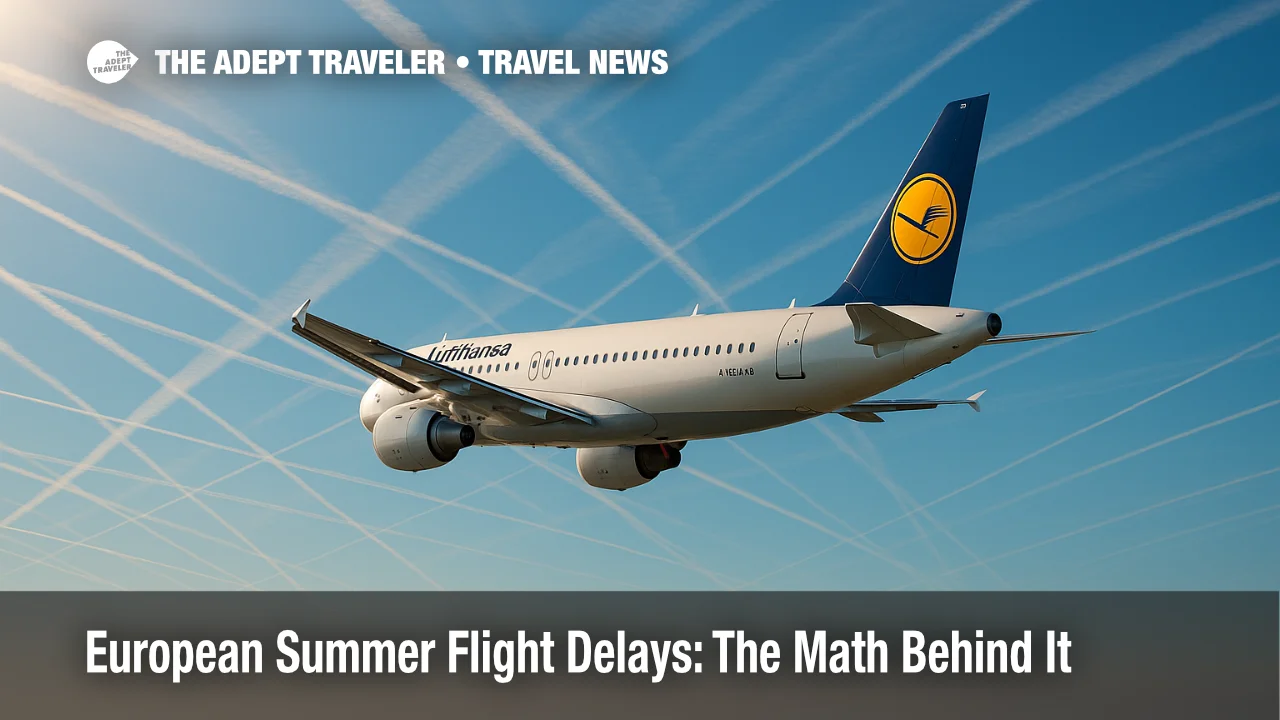European Summer Flight Delays: The Math Behind the Crunch

Europe's sky is running out of elbow room. Brussels and Eurocontrol concede that the network's peak-day ceiling-about 37 000 flights-already fills every usable corridor of airspace. That hard cap leaves no slack for staffing shortages, thunderstorms, or the next air-traffic-control (ATC) walkout. With traffic 4 percent higher than last year and some sectors handling 40 percent more flights than in 2019, even a modest disruption now multiplies across the continent, stretching gate slots, crew duty limits, and aircraft rotations. Understanding the arithmetic of capacity helps travelers grasp why a brief French strike or a fast-moving weather front can ripple into hours-long delays two countries away.
Key Points
- Why it matters: Europe averages 1 542 flights an hour-one every 2.3 seconds-when demand peaks.
- The network lost 20 percent of usable routes after Russian airspace closed, funneling more traffic through bottlenecks.
- ATC causes led to 61 915 minutes of delay per day in 2024; this summer's load is heavier.
- Each additional two-minute delay per flight adds 54 days of cumulative hold-time network-wide.
- Single European Sky reforms would let controllers re-route traffic dynamically and cut duplication, but stalemate persists.
Snapshot
Eurocontrol forecasts that Fridays in late July and early August will again flirt with the pre-pandemic record of 37 228 flights. At that tempo, Europe moves roughly 25.7 flights a minute. Meanwhile, average en-route ATFM delay crept back above 2.5 minutes per flight in June 2025, despite benign weather. Soft staffing caps in France, Germany, and the eastern Mediterranean mean fewer sectors can open during overtime bans or industrial action. With only 80 percent of 2019's airspace still available-thanks largely to Russia's closure-traffic squeezes through narrower lanes, forcing longer routings and squeezing vertical separation.
Background
The Single European Sky concept, first proposed in 2004, aims to fuse 27 national ATC systems into one seamless network. Fragmentation currently costs airlines about $6 billion a year in extra fuel, staffing, and delay compensation. Yet member-state sovereignty concerns have stalled key planks such as performance-based route charging and cross-border sector design. Eurocontrol data show that 44 percent of last summer's en-route delays stemmed from ATC capacity shortfalls, eclipsing weather for the first time in a decade. Airlines argue that without structural reform, hiring a few hundred extra controllers will barely dent the problem because each country still guards its airspace silos.
Latest Developments
Peak-Day Bottleneck Reached
Eurocontrol's Week 29 Flash Briefing logged 37 034 flights on July 18-within 200 flights of the all-time record. Controllers in south-west Europe handled 30-40 percent more traffic than in 2019, yet sector staffing remained flat. The agency warns that if daily demand exceeds 37 100 flights, it must issue pre-emptive flow restrictions, lengthening routings by an average 70 nautical miles and adding ten minutes of flight time. Airlines say that pushes fuel burn per narrow-body leg up by 800 pounds, a costly margin when sustainable-aviation-fuel mandates are rising.
Strike Threats Multiply
Industrial tension compounds the squeeze. A four-hour Italy airport strike on July 26 will coincide with a Volotea crew walkout, while French unions hint at another national stoppage if pay talks stall. July's earlier French ATC strike canceled more than 1 000 flights and delayed 63 000 others across Europe. Eurocontrol models suggest that every ten percent drop in available French sectors can raise average en-route delay by 20 percent region-wide within three hours because traffic must skirt French airspace or stack at boundaries.
Analysis
Delay math is brutally cumulative. With 37 000 daily flights, a seemingly minor two-minute average hold adds 77 700 minutes-1 295 hours-of network delay each day. Because aircraft generally operate three to six legs daily, an early-morning snag often snowballs into missed curfews at slot-coordinated hubs such as Amsterdam-Schiphol and London-Heathrow. Crews then time-out, triggering cancellations that strand aircraft and create next-day knock-ons. In 2024, Eurocontrol tallied €2.8 billion in delay costs borne by airlines and passengers. Absent Single European Sky reforms, 2025 could surpass that figure-even if weather stays calm-because peak traffic is higher and diversions around conflict zones remain.
The maths also expose why incremental fixes fall short. Adding 200 controllers across Europe would lift theoretical capacity by perhaps 1 percent, barely 370 flights a day-still below projected demand growth. By contrast, merging fragmented upper sectors could raise capacity by 5-10 percent without new hires, Eurocontrol estimates, because aircraft would enjoy more direct routings and fewer hand-offs. Until political appetite matches technical feasibility, passengers should expect airlines to pad schedules and warn of longer block times, particularly on intra-EU hops under two hours.
Final Thoughts
Travelers planning peak-summer itineraries should build in generous layovers and avoid tight same-day connections. Europe's network is operating at its mathematical threshold; any strike, storm, or wildfire can tip the balance and inflate European summer flight delays for days. Without decisive Single European Sky action, the continent's delay arithmetic is set to get worse before it gets better.
